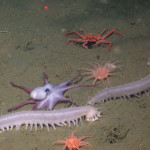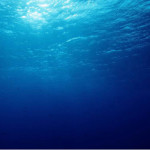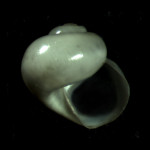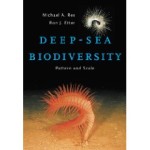It’s a hard knock life for deep-sea animals. It’s really cold in the winter. It’s really cold in the summer. It’s dark and wet…like Boston and Guinness. Your only source of food, what little you get, is far from fresh and may have passed through the rectum of more than one animal. If you are a deep-sea organism, you’ve probably asked yourself on more than on occasion how you wound up in this god-for-saken pit of despair.
Lucky deep-sea organisms get the paradise described above. Ones not so lucky live their lives in the oxygen minimum zone. This is exactly what it sounds like, an area of no to little oxygen. It even comes with a clever acronym that makes it sound like a combat zone, OMZ. OMZ’s typically occur at depths of 200-1000 meters forming a band of low oxygen hell in the eastern Pacific, southeast Atlantic, Arabian Sea and the Bay of Bengal. In OMZ’s larger organisms fair the worse with their numbers typically suppressed. In contrast, in really small organisms, e.g. bacteria, copepods, nematodes, ostracods, forams and the like, the numbers are the same in and out of the OMZ. What is also clear is that to survive the OMZ, an organism needs to be packing the right physiological and anatomical toolset. Accordingly, OMZ species are different than their non-OMZ counterparts.
A new suite of excellent studies on the Pakistan OMZ in the NE Arabian Sea was unleashed in the recent issue of Deep-Sea Research II. The set of multidisplinary studies exhaustively examines the biological and geochemical processes in this particularly thick (150-1300m) and extreme (near 0 ml/L oxygen concentrations) OMZ. That’s what she said. This OMZ is the grandpappy of all OMZ’s. Some of the findings of the group are that indeed the Pakistan OMZ is hell-hole that becomes more or less so as a result of monsoonal variation, that microbial processes and bioturbation are predictably affected by the suckiness of OMZ life, and even the organic material is more degraded than predicted. In the core of the Pakistan OMZ (250-750m), where oxygen hits a record low, larger organisms are extremely rare, even more so than other OMZ’s like the nearby Oman OMZ. All the large organisms move to the OMZ suburbs leaving behind the forams to do as the like and do it absence of predators like ispods and scaphopods. Of course, until an “urban planning commission” “revitalizes” the neighborhood and everyone comes back to the city. Sorry I got caught up in the analogy. Finally, given the harsh conditions of an OMZ and the requirements needed to live in one, a rapid turnover in species makeup is observable as you progress through and out of the OMZ.
Gooday, A., Levin, L., Aranda da Silva, A., Bett, B., Cowie, G., Dissard, D., Gage, J., Hughes, D., Jeffreys, R., & Lamont, P. (2009). Faunal responses to oxygen gradients on the Pakistan margin: A comparison of foraminiferans, macrofauna and megafauna Deep Sea Research Part II: Topical Studies in Oceanography, 56 (6-7), 488-502 DOI: 10.1016/j.dsr2.2008.10.003
Cowie, G., & Levin, L. (2009). Benthic biological and biogeochemical patterns and processes across an oxygen minimum zone (Pakistan margin, NE Arabian Sea) Deep Sea Research Part II: Topical Studies in Oceanography, 56 (6-7), 261-270 DOI: 10.1016/j.dsr2.2008.10.001






Wow . . . did not know these existed. You make them sound only slightly more appealing than life in Guantanamo Bay, a Soviet Gulag, Detroit, or similar. *ducks*
Now I know what a that’s what she said jokes is but you took it to the next level. I guess you can make a twss joke out of anything